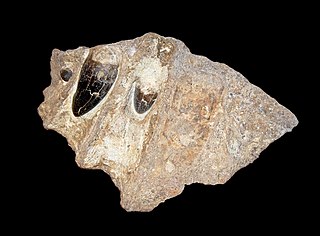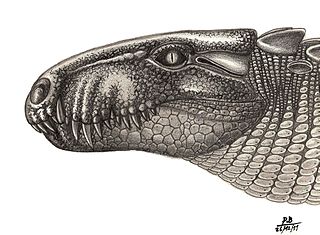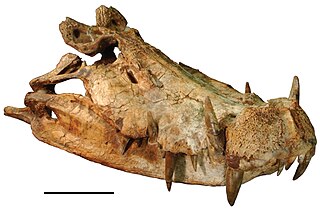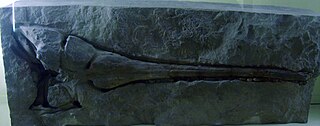
Simosuchus is an extinct genus of notosuchian crocodyliforms from the Late Cretaceous of Madagascar. It is named for its unusually short skull. Fully grown individuals were about 0.75 metres (2.5 ft) in length. The type species is Simosuchus clarki, found from the Maevarano Formation in Mahajanga Province, although one isolated multicuspid tooth of this genus was discovered in Kallamedu Formation of India.

Comahuesuchus is an extinct genus of notosuchian crocodylomorphs from the late Cretaceous of Argentina. It was described by palaeontologist José Bonaparte in 1991. The type species is C. brachybuccalis from the Santonian Bajo de la Carpa Formation. In 2023 another species, C. bonapartei from the Sierra Barrosa Formation and Portezuelo Formation, was assigned to the genus.

Razanandrongobe is a genus of carnivorous ziphosuchian crocodyliform from the Middle Jurassic of Madagascar. It contains the type and only species Razanandrongobe sakalavae, named in 2004 by Simone Maganuco and colleagues based on isolated bones found in 2003. The remains, which included a fragment of maxilla and teeth, originated from the Bathonian-aged Sakaraha Formation of Mahajanga, Madagascar. While they clearly belonged to a member of the Archosauria, Maganuco and colleagues refrained from assigning the genus to a specific group because the fragmentary remains resembled lineages among both the theropod dinosaurs and crocodylomorphs.
Paleontology or palaeontology is the study of prehistoric life forms on Earth through the examination of plant and animal fossils. This includes the study of body fossils, tracks (ichnites), burrows, cast-off parts, fossilised feces (coprolites), palynomorphs and chemical residues. Because humans have encountered fossils for millennia, paleontology has a long history both before and after becoming formalized as a science. This article records significant discoveries and events related to paleontology that occurred or were published in the year 2000.
Paleontology or palaeontology is the study of prehistoric life forms on Earth through the examination of plant and animal fossils. This includes the study of body fossils, tracks (ichnites), burrows, cast-off parts, fossilised feces (coprolites), palynomorphs and chemical residues. Because humans have encountered fossils for millennia, paleontology has a long history both before and after becoming formalized as a science. This article records significant discoveries and events related to paleontology that occurred or were published in the year 2002.

Notosuchia is a suborder of primarily Gondwanan mesoeucrocodylian crocodylomorphs that lived during the Jurassic and Cretaceous. Some phylogenies recover Sebecosuchia as a clade within Notosuchia, others as a sister group ; if Sebecosuchia is included within Notosuchia its existence is pushed into the Middle Miocene, about 11 million years ago. Fossils have been found from South America, Africa, Asia, and Europe. Notosuchia was a clade of terrestrial crocodilians that evolved a range of feeding behaviours, including herbivory (Chimaerasuchus), omnivory (Simosuchus), and terrestrial hypercarnivory (Baurusuchus). It included many members with highly derived traits unusual for crocodylomorphs, including mammal-like teeth, flexible bands of shield-like body armor similar to those of armadillos (Armadillosuchus), and possibly fleshy cheeks and pig-like snouts (Notosuchus). The suborder was first named in 1971 by Zulma Gasparini and has since undergone many phylogenetic revisions.
Neuquensuchus is an extinct genus of crocodyliform from the Santonian-age Upper Cretaceous Bajo de la Carpa Formation of Neuquén Province, Argentina. The known remains were discovered on the campus of Universidad Nacional del Comahue in the city of Neuquén. Neuquensuchus was named by Lucas E. Fiorelli and Jorge O. Calvo in a publication dated to 2007, but which became available in 2008. The type species is N. universitas, in recognition of its discovery locality. Unlike the great majority of crocodyliforms, its shin was longer than its thigh, suggesting it had some running ability.

Baurusuchidae is a Gondwanan family of mesoeucrocodylians that lived during the Late Cretaceous. It is a group of terrestrial hypercarnivorous crocodilians from South America and possibly Pakistan. Baurusuchidae has been, in accordance with the PhyloCode, officially defined as the least inclusive clade containing Cynodontosuchus rothi, Pissarrachampsa sera, and Baurusuchus pachecoi. Baurusuchids have been placed in the suborder Baurusuchia, and two subfamilies have been proposed: Baurusuchinae and Pissarrachampsinae.

Neosuchia is a clade within Mesoeucrocodylia that includes all modern extant crocodilians and their closest fossil relatives. It is defined as the most inclusive clade containing all crocodylomorphs more closely related to Crocodylus niloticus than to Notosuchus terrestris. Members of Neosuchia generally share a crocodilian-like bodyform adapted to freshwater aquatic life, as opposed to the terrestrial habits of more basal crocodylomorph groups. The earliest neosuchian is suggested to be the Early Jurassic Calsoyasuchus, which lived during the Sinemurian and Pliensbachian stages in North America. It is often identified as a member of Goniopholididae, though this is disputed, and the taxon may lie outside Neosuchia, which places the earliest records of the group in the Middle Jurassic.

Bretesuchus is an extinct genus of sebecosuchian mesoeucrocodylian within the family Sebecidae known from northwestern Argentina. It was a large apex predator.
Eremosuchus is an extinct genus of sebecosuchian mesoeucrocodylian. Fossils have been found from El Kohol, Algeria of Eocene age. It had serrated, ziphodont teeth.

Kaprosuchus is an extinct genus of mahajangasuchid crocodyliform. It is known from a single nearly complete skull collected from the Upper Cretaceous Echkar Formation of Niger. The name means "boar crocodile" from the Greek κάπρος, kapros ("boar") and σοῦχος, soukhos ("crocodile") in reference to its unusually large caniniform teeth which resemble those of a boar. It has been nicknamed "BoarCroc" by Paul Sereno and Hans Larsson, who first described the genus in a monograph published in ZooKeys in 2009 along with other Saharan crocodyliformes such as Anatosuchus and Laganosuchus. The type species is K. saharicus.

Pholidosaurus is an extinct genus of neosuchian crocodylomorph. It is the type genus of the family Pholidosauridae. Fossils have been found in northwestern Germany. The genus is known to have existed during the Berriasian-Albian stages of the Early Cretaceous. Fossil material found from the Annero and Jydegård Formations in Skåne, Sweden and on the island of Bornholm, Denmark, have been referred to as a mesoeucrocodylian, and possibly represent the genus Pholidosaurus.

Sebecus is an extinct genus of sebecid crocodylomorph from Eocene of South America. Like other sebecosuchians, it was entirely terrestrial and carnivorous. The genus is currently represented by two species, the type S. icaeorhinus and S. ayrampu. Several other species have been referred to Sebecus, but were later reclassified as their own genera.

Comahuesuchidae is a family of notosuchian crocodyliforms. Constructed in 1991, it includes the genera Comahuesuchus and Anatosuchus. Among the characteristics that are unique to this family is an external naris that is inset into the tip of the snout. There is also a diastema, or gap between the teeth, at the tip of the upper and lower jaws. Both Anatosuchus and Comahuesuchus have maxillary tooth rows in the upper jaw that extend out and over the dentary tooth rows of the lower jaw.
Sebecosuchia is an extinct group of mesoeucrocodylian crocodyliforms that includes the families Sebecidae and Baurusuchidae. The group was long thought to have first appeared in the Late Cretaceous with the baurusuchids and become extinct in the Miocene with the last sebecids, but Razanandrongobe pushes the origin of Sebecosuchia to the Middle Jurassic. Fossils have been found primarily from South America but have also been found in Europe, North Africa, Madagascar, and the Indian subcontinent.

Ischyrochampsa is an extinct monospecific genus of Late Cretaceous crocodyliform belonging to the eusuchian clade Allodaposuchidae. Fossils of the type species I. meridionalis are late Campanian in age and were found in the commune of Saint-Estève-Janson in Bouches-du-Rhône, France. Material is also known from Spain. It was named and described in 1995, and it had an estimated length of over 4 metres (13 ft).
Wanosuchus is an extinct genus of sebecosuchian mesoeucrocodylian known from Paleocene-age rocks of southern Anhui, China. It is based on IVPP V 6262, a nearly complete lower jaw, which is also the only known specimen. The bone lacks an external mandibular fenestra and has thirteen teeth, the longest of which are the fourth and eleventh. It was collected between 1970 and 1972 by Institute of Vertebrate Paleontology and Paleoanthropology (IVPP) personnel; the exact location and rock unit that produced the bone are uncertain. Wanosuchus was named in 1981 by Zhang Fakui of the IVPP. The type species is W. atresus, a reference to the absent fenestra. Zhang classified Wanosuchus under its own family within Sebecosuchia, Wanosuchidae. It shares some characteristics with Doratodon, a crocodyliform from the Late Cretaceous of Europe.
Paluxysuchus is an extinct genus of neosuchian crocodyliform known from the Early Cretaceous Twin Mountains Formation of north-central Texas. It contains a single species, Paluxysuchus newmani. Paluxysuchus is one of three crocodyliforms known from the Early Cretaceous of Texas, the others being Pachycheilosuchus and an unnamed species referred to as the "Glen Rose Form". Paluxysuchus has a long, flat skull that is probably transitional between the long and narrow skulls of many early neosuchians and the short and flat skulls of later neosuchians.
Lavocatchampsa is an extinct genus of notosuchian mesoeucrocodylian known from the Late Cretaceous Kem Kem Beds in Morocco. It contains a single species, Lavocatchampsa sigogneaurusselae.












